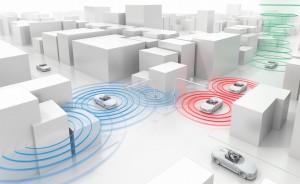
Audi's new Traffic light system will give Q7 and A4 drivers warnings about when traffic lights will change.
Hate waiting for the stop light to change or get that pit in your stomach when as you stomp on the gas pedal because a light has just turned yellow? Audi is ready to alleviate that anxiety for its customers.
The German maker’s 2017 Q7, A4 and A4 Allroad models will feature the first commercial use of “V2I” – vehicle to infrastructure – technology. The technology allows Audi vehicles to “talk” to traffic signals, giving drivers a little advanced warning about what’s to come.
It will be available on the aforementioned models built after June 1.
Audi’s Traffic light information, an Audi connect PRIME feature, enables the car to communicate with the infrastructure in select cities and metropolitan areas across the U.S. The car receives real-time signal information from the advanced traffic management system that monitors traffic lights.
The link between vehicle and infrastructure is routed via the on-board LTE data connection and Traffic Technology Services, Inc. servers.
“This feature represents Audi’s first step in vehicle-to-infrastructure integration,” said Pom Malhotra, General Manager, Connected Vehicles. Malhotra believes in its current form, the system is more of a convenience feature, but it could be expanded to improve road safety and improve the environment.
“In the future we could envision this technology integrated into vehicle navigation, start / stop functionality and can even be used to help improve traffic flow in municipalities. These improvements could lead to better overall efficiency and shorter commuting times.”
(Audi planning three battery-powered cars by 2020. For more, Click Here.)
Eventual applications of the technology, which continues to be tested across the globe by carmakers and transportation agencies, will help mitigate crashes and reduce congestion on roads and highways. For now, the system helps take the edge off dealing with intersections.
The system can display a countdown before a red light changes to green. Taking the guess work of how long a driver will be “stuck” at a traffic light can cut down on the anxiety of driving, Audi officials believe.
To avoid potential problems of drivers trying to time the light as they wait, Malhotra said the countdown will disappear a few second before the light changes to green. Ideally, this will force drivers to actually wait and see the light change and to check the intersection to make sure it’s clear before proceeding.
(Click Here for details about Audi’s 67-month sales increase streak.)
Audi’s system also works in reverse, in a manner of speaking. As a driver approaches an intersection the countdown also appear on the dashboard if the vehicle determines it will not be able to make an approaching light before it turns red, to allow the driver to begin to brake.
“Continuous innovation in connected car services and advanced driver assistance systems that enrich and improve the customer experience is at the core of the Audi brand and our collective future,” said Scott Keogh, President, Audi of America, in a statement.
V2I technology has potential applications beyond the convenience of knowing when a traffic light will change. It could be linked to navigation systems to further improve traffic flow, help with stop/start systems for fuel consumption and even tell drivers what speed to drive to ensure they catch lights when they are green instead of red.
(Used car buyers get charged up about hybrids, plug-ins and EVs. Click Here for the story.)
Audi will roll out the program in as many as seven U.S. cities this year, but officials would not disclose which cities would be first.

